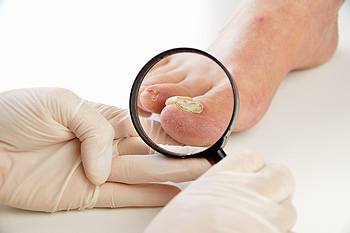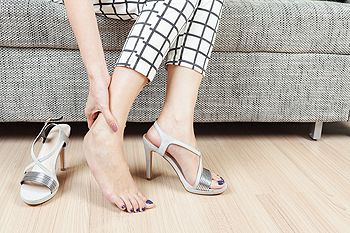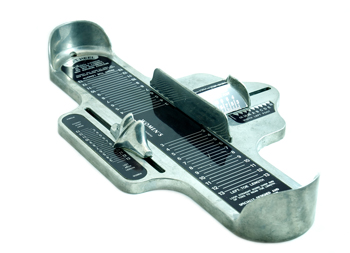Connect With Us
Blog
Items filtered by date: September 2021
The Toll High Heels Take On Your Feet
It is no secret that wearing high heels every day can be damaging to your feet and legs. Wearing them also creates a reduction in range of movement, balance control, step length, and ankle muscle movement. Some studies even suggest that musculoskeletal disorders may occur later in life as a result of wearing high heels regularly. A study conducted by the University of Alabama at Birmingham points to a doubling of high heel shoe-related injuries over a 10-year period, with most of those injuries affecting the feet and ankles. If you wear high heels on a regular basis and are experiencing any pain or discomfort, make an appointment with a podiatrist. They can examine and test you to diagnose the problem, as well as discuss treatment options which may include custom orthotics and footwear modifications to reduce the harmful effects high heels may be having on your feet and ankles.
High heels have a history of causing foot and ankle problems. If you have any concerns about your feet or ankles, contact Scott Matthews, DPM, MD from Salem Foot Care . Our doctor can provide the care you need to keep you pain-free and on your feet.
Effects of High Heels on the Feet
High heels are popular shoes among women because of their many styles and societal appeal. Despite this, high heels can still cause many health problems if worn too frequently.
Which Parts of My Body Will Be Affected by High Heels?
- Ankle Joints
- Achilles Tendon – May shorten and stiffen with prolonged wear
- Balls of the Feet
- Knees – Heels cause the knees to bend constantly, creating stress on them
- Back – They decrease the spine’s ability to absorb shock, which may lead to back pain. The vertebrae of the lower back may compress.
What Kinds of Foot Problems Can Develop from Wearing High Heels?
- Corns
- Calluses
- Hammertoe
- Bunions
- Morton’s Neuroma
- Plantar Fasciitis
How Can I Still Wear High Heels and Maintain Foot Health?
If you want to wear high heeled shoes, make sure that you are not wearing them every day, as this will help prevent long term physical problems. Try wearing thicker heels as opposed to stilettos to distribute weight more evenly across the feet. Always make sure you are wearing the proper shoes for the right occasion, such as sneakers for exercising. If you walk to work, try carrying your heels with you and changing into them once you arrive at work. Adding inserts to your heels can help cushion your feet and absorb shock. Full foot inserts or metatarsal pads are available.
If you have any questions please feel free to contact our office located in Wikesboro, NC . We offer the newest diagnostic and treatment technologies for all your foot and ankle needs.
Can Toenail Fungus Be Prevented?
 The medical term for toenail fungus is known as onychomycosis. It is considered to be the most common of nail diseases among adults and can be quite unsightly. Conditions that can include diabetes and ailments that suppress the immune system may lead to the development of toenail fungus. This condition is caused by a specific type of fungus that lives and thrives in warm and moist environments. These types of places can include public swimming pools, locker rooms, and surrounding areas. Common symptoms that many people experience can include yellow and thickened nails, and in severe cases, the nail may have an odor. Effective prevention techniques can consist of wearing appropriate shoes while in these places, and refrain from sharing towels and socks. It is suggested that you visit a podiatrist if you have any of these symptoms, who can help create the correct treatment plan for you.
The medical term for toenail fungus is known as onychomycosis. It is considered to be the most common of nail diseases among adults and can be quite unsightly. Conditions that can include diabetes and ailments that suppress the immune system may lead to the development of toenail fungus. This condition is caused by a specific type of fungus that lives and thrives in warm and moist environments. These types of places can include public swimming pools, locker rooms, and surrounding areas. Common symptoms that many people experience can include yellow and thickened nails, and in severe cases, the nail may have an odor. Effective prevention techniques can consist of wearing appropriate shoes while in these places, and refrain from sharing towels and socks. It is suggested that you visit a podiatrist if you have any of these symptoms, who can help create the correct treatment plan for you.
If left untreated, toenail fungus may spread to other toenails, skin, or even fingernails. If you suspect you have toenail fungus it is important to seek treatment right away. For more information about treatment, contact Scott Matthews, DPM, MD of Salem Foot Care . Our doctor can provide the care you need to keep you pain-free and on your feet.
Symptoms
- Warped or oddly shaped nails
- Yellowish nails
- Loose/separated nail
- Buildup of bits and pieces of nail fragments under the nail
- Brittle, broken, thickened nail
Treatment
If self-care strategies and over-the-counter medications does not help your fungus, your podiatrist may give you a prescription drug instead. Even if you find relief from your toenail fungus symptoms, you may experience a repeat infection in the future.
Prevention
In order to prevent getting toenail fungus in the future, you should always make sure to wash your feet with soap and water. After washing, it is important to dry your feet thoroughly especially in between the toes. When trimming your toenails, be sure to trim straight across instead of in a rounded shape. It is crucial not to cover up discolored nails with nail polish because that will prevent your nail from being able to “breathe”.
In some cases, surgical procedure may be needed to remove the toenail fungus. Consult with your podiatrist about the best treatment options for your case of toenail fungus.
If you have any questions, please feel free to contact our office located in Wikesboro, NC . We offer the newest diagnostic and treatment technologies for all your foot care needs.
Buying Shoes That Feel Comfortable
By wearing shoes that fit well, you can prevent the development of many foot conditions such as bunions, corns, calluses, hammertoes, blisters, ingrown toenails, plantar fasciitis, Morton’s neuroma and more. Start by knowing your true size. You may think your feet are the same size as they were a few years ago, however, age, changes in weight, and other factors may cause your feet to grow and expand. Have your feet measured every time you buy shoes—both in length and width. Make sure you try shoes on at the end of the day, after your feet have expanded. Check for ⅜” to ½” of space between the tip of the shoe and your big toe, and that the ball of your feet don’t feel squeezed. Don’t buy shoes that feel uncomfortable thinking they will expand, or that you will wear them in later. Walk around the store for a while to get a real sense of their fit. Make sure you don’t slip around in them or that they cause friction by rubbing against your feet, toes, back of your heel, etc. If you are struggling to find the shoes with the right fit for you, a podiatrist can offer additional tips for buying shoes that are appropriate for your particular feet.
Getting the right shoe size is an important part of proper foot health. Seek the assistance of Scott Matthews, DPM, MD from Salem Foot Care . Our doctor will provide the care you need to keep you pain-free and on your feet.
Getting the Right Shoe Size
There are many people who wear shoes that are the incorrect size, negatively affecting their feet and posture. Selecting the right shoes is not a difficult process, so long as you keep several things in mind when it comes to choosing the right pair.
- When visiting the shoe store, use the tools available to measure your foot.
- Be sure there is ‘wiggle room’. There should be about an inch between your toes and the tip of your shoes.
- Do not always assume you are the same size, as manufacturers run differently.
- Purchase shoes later in the day, as your feet swell as the day progresses.
- If a shoe is not comfortable, it is not suitable. Most shoes can’t be ‘broken in’, and comfort should be the ultimate goal when it comes to choosing the right pair of shoes
As our feet hold our body weight and keep us moving, it is important to treat them right. Picking the right pair of shoes can provide your feet comfort and mobility without pain.
If you have any questions, please feel free to contact our office located in Wikesboro, NC . We offer the newest diagnostic and treatment technologies for all your foot care needs.
Can Foot Pain Be Avoided During Pregnancy?
 Swollen feet are a common ailment among pregnant women. As their belly grows so does the baby, and with this the feet tend to become bigger. This may be a result of thickened blood that develops during pregnancy, in addition to standing on the feet for most of the day. Research has indicated there are several different things that can be done to help alleviate foot pain during pregnancy. It is beneficial to elevate the feet as often as possible, as this may help to reduce existing swelling. Additionally, it can help to flex and point the feet at various times during the day to help improve circulation. Patients may see a noticeable difference in choosing shoes that are wide and have a low heel. Wearing cotton socks can help to avoid sweating and may improve comfort. If you would like more information about how to avoid foot pain during pregnancy, please consult with a podiatrist.
Swollen feet are a common ailment among pregnant women. As their belly grows so does the baby, and with this the feet tend to become bigger. This may be a result of thickened blood that develops during pregnancy, in addition to standing on the feet for most of the day. Research has indicated there are several different things that can be done to help alleviate foot pain during pregnancy. It is beneficial to elevate the feet as often as possible, as this may help to reduce existing swelling. Additionally, it can help to flex and point the feet at various times during the day to help improve circulation. Patients may see a noticeable difference in choosing shoes that are wide and have a low heel. Wearing cotton socks can help to avoid sweating and may improve comfort. If you would like more information about how to avoid foot pain during pregnancy, please consult with a podiatrist.
Pregnant women with swollen feet can be treated with a variety of different methods that are readily available. For more information about other cures for swollen feet during pregnancy, consult with Scott Matthews, DPM, MD from Salem Foot Care . Our doctor will attend to all of your foot and ankle needs.
What Foot Problems Can Arise During Pregnancy?
One problem that can occur is overpronation, which occurs when the arch of the foot flattens and tends to roll inward. This can cause pain and discomfort in your heels while you’re walking or even just standing up, trying to support your baby.
Another problem is edema, or swelling in the extremities. This often affects the feet during pregnancy but tends to occur in the later stages.
How Can I Keep My Feet Healthy During Pregnancy?
- Wearing orthotics can provide extra support for the feet and help distribute weight evenly
- Minimize the amount of time spent walking barefoot
- Wear shoes with good arch support
- Wear shoes that allow for good circulation to the feet
- Elevate feet if you experience swelling
- Massage your feet
- Get regular, light exercise, such as walking, to promote blood circulation to the feet
If you have any questions please feel free to contact our office located in Wikesboro, NC . We offer the newest diagnostic and treatment technologies for all your foot and ankle needs.
Blog Archives
- March 2025
- February 2025
- January 2025
- December 2024
- November 2024
- October 2024
- September 2024
- August 2024
- July 2024
- June 2024
- May 2024
- April 2024
- March 2024
- February 2024
- January 2024
- December 2023
- November 2023
- October 2023
- September 2023
- August 2023
- July 2023
- June 2023
- May 2023
- April 2023
- March 2023
- February 2023
- January 2023
- December 2022
- November 2022
- October 2022
- September 2022
- August 2022
- July 2022
- June 2022
- May 2022
- April 2022
- March 2022
- February 2022
- January 2022
- December 2021
- November 2021
- October 2021
- September 2021
- August 2021
- July 2021
- June 2021
- May 2021
- April 2021
- March 2021
- February 2021
- January 2021
- December 2020
- November 2020
- October 2020
- September 2020
- August 2020
- July 2020
- June 2020
- May 2020
- April 2020
- March 2020
- February 2020
- January 2020
- December 2019
- November 2019
- October 2019
- September 2019
- August 2019
- July 2019
- June 2019
- May 2019
- April 2019
- March 2019
- February 2019
- January 2019
- December 2018
- November 2018
- October 2018
- September 2018
- August 2018
- July 2018
- June 2018
- May 2018



